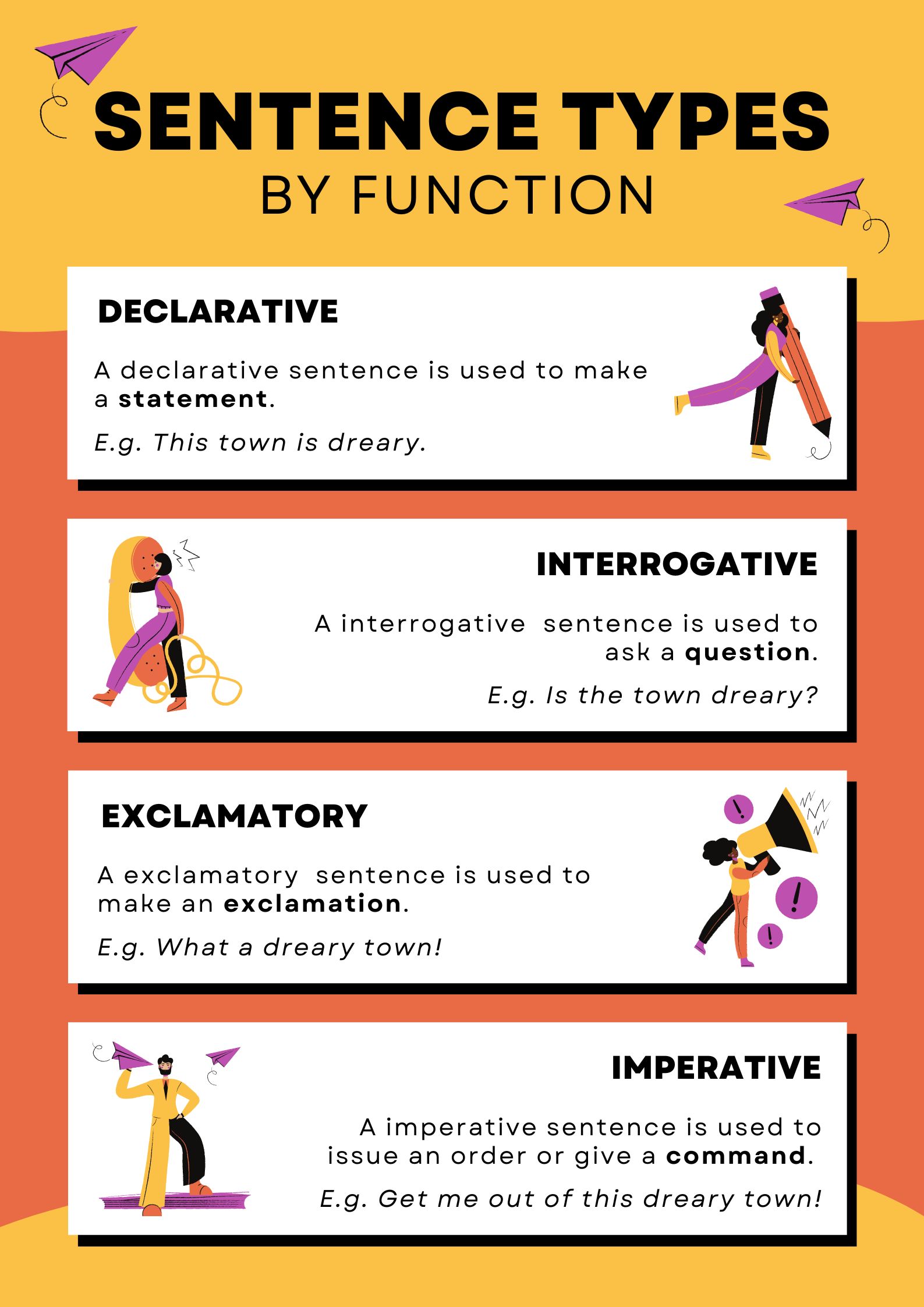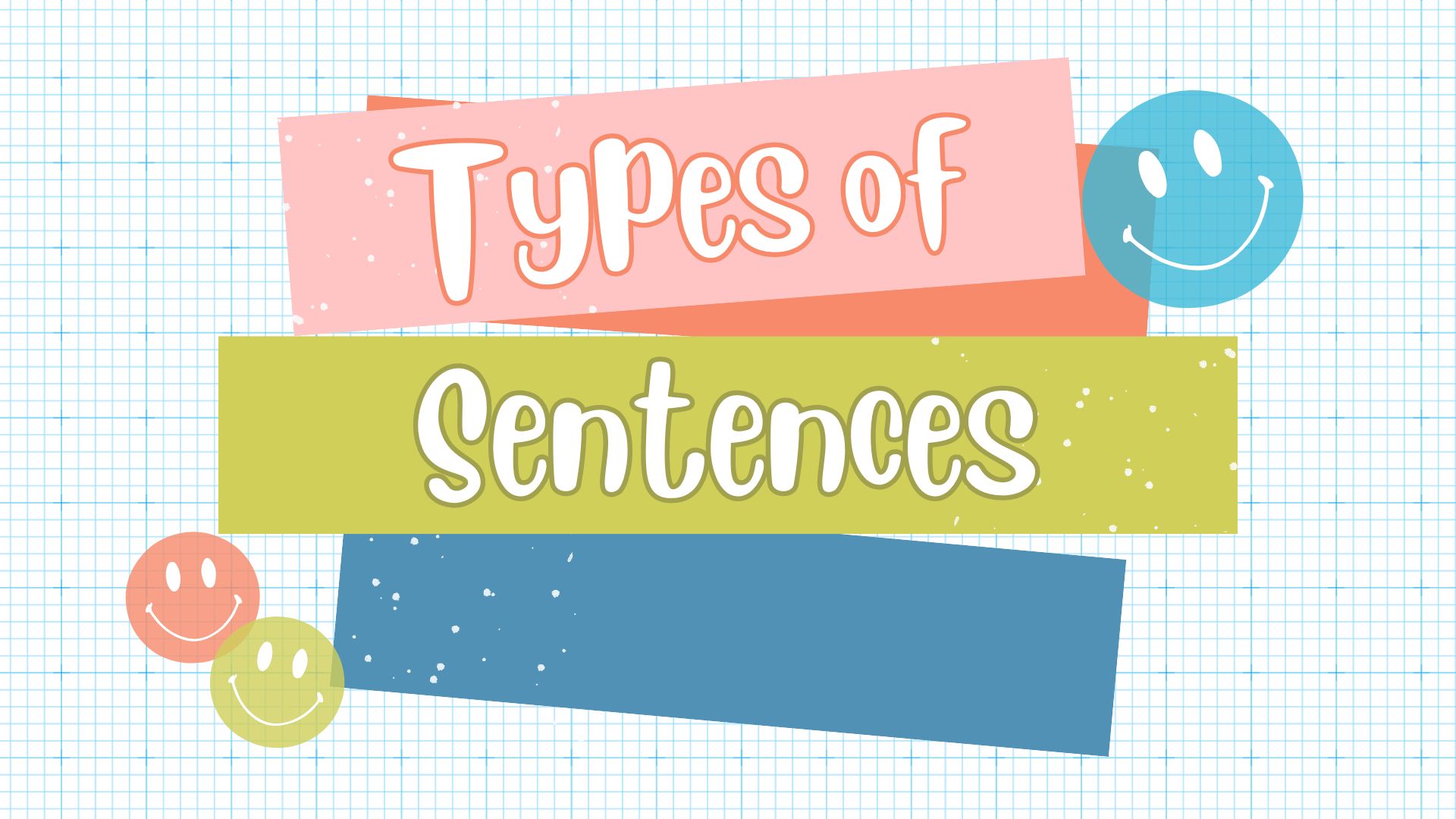Introduction
A sentence is a group of words that reflects a complete thought. It is the basic building block in written and spoken communication. A sentence will normally have a subject—what or whom the sentence is about—and a predicate, which tells what’s being said about the subject; it also must convey a complete, clear idea. Though sentences can run from simple statements to highly complex structures, they serve basically to get a message across—their object is to convey meaning effectively and accurately. Knowledge of different types and structures of sentences is necessary for effective communication and comprehension.
The different kinds of sentences are:

Declarative sentence:
A declarative sentence is one kind of sentence that states something, expresses an idea, opinion, or fact. It is the most common in English. Declarative sentences inform about something and use a period at the end. Structurally, declarative sentences usually follow the subject-verb-object word order and could be simple or complex.
Examples:
- The sky is blue.
- She enjoys reading books.
- The meeting starts at 9 AM.
- They are planning a trip to Japan.
Types of declarative sentence:
Declarative sentences, which make statements or provide information, can be categorized based on their function, structure, and content. Here are the main types:
1.Simple Declarative Sentences
These sentences consist of a single independent clause with a straightforward subject-verb-object structure.
- Example: “She enjoys reading.”
- Purpose: To state a fact or opinion clearly and directly.
2.Compound Declarative Sentence
These sentences contain two or more independent clauses joined by a coordinating conjunction (and, but, or, nor, for, so, yet).
- Example: “She enjoys reading, and he likes writing.”
- Purpose: To connect related ideas or provide additional information.
3.Complex Declarative Sentences
These sentences have one independent clause and at least one dependent clause, connected by subordinating conjunctions (because, although, since, unless, etc.).
- Example: “She enjoys reading because it relaxes her.”
- Purpose: To provide a main idea along with supporting details or explanations.
4.Negative Declarative Sentences
These sentences state negative facts or assertions, often using the word “not” or “no.”
- Example: “She does not enjoy reading.”
- Purpose: To deny or negate information.
5.Emphatic Declarative Sentences
These sentences emphasize a particular fact or statement, often using words like “really” or “definitely” for emphasis.
- Example: “She really enjoys reading.”
- Purpose: To stress the importance or certainty of a statement.
Uses of declarative sentence:
Declarative sentences are straightforward and are used to convey information clearly and directly.
Declarative sentences can be used for various purposes, including:
1.Providing General Information
Declarative sentences are used to share everyday information about routines or common occurrences.
- Example: “The store opens at 9 AM.”
- Purpose: To inform about the store’s opening time.
2.Stating Facts
They are employed to present facts or truths, whether they are general, scientific, or historical.
- Example: “Water boils at 100 degrees Celsius.”
- Purpose: To convey a scientific fact.
3.Explaining Concepts
Declarative sentences help explain ideas, concepts, or processes.
- Example: “Photosynthesis is the process by which plants convert sunlight into energy.”
- Purpose: To explain how photosynthesis works.
4.Sharing Opinions or Beliefs
They are used to express personal opinions, beliefs, or viewpoints.
- Example: “I believe that exercise is essential for good health.”
- Purpose: To share a personal belief.
5.Describing Objects or Situations
Declarative sentences can describe the characteristics or details of objects, places, or situations.
- Example: “The new building is located downtown and has 20 floors.”
- Purpose: To describe the location and features of a building.
6.Making Announcements
They are useful for making public or formal announcements.
- Example: “The meeting has been rescheduled to next Monday.”
- Purpose: To announce a change in the meeting schedule.
7.Providing Instructions or Directions
Declarative sentences can be used to give instructions or directions clearly and concisely.
- Example: “Mix the flour and sugar before adding the eggs.”
- Purpose: To provide a step in a recipe.
8.Reporting Events
They are often used in news reports and narratives to describe events or occurrences.
- Example: “The team won the championship game last night.”
- Purpose: To report a recent event.
9.Offering Explanations or Justifications
Declarative sentences help in explaining reasons or justifying actions.
- Example: “She apologized because she was late.”
- Purpose: To explain why she apologized.
10.Making Requests or Commands Indirectly
Although commands are usually given in imperative sentences, declarative sentences can be used to make polite requests or suggestions.
- Example: “You might want to check your email for updates.”
- Purpose: To suggest checking the email without directly commanding.
The Word Order in a Declarative Sentence:
The word order of a declarative sentence typically follows the Subject-Verb-Object (SVO) structure. Here’s a breakdown:
- Subject: The person, place, thing, or idea that is doing or being something.
- Verb: The action or state of being.
- Object: The entity that is affected by the action of the verb (if there is one).
For example:
- “The cat (subject) sat (verb) on the mat (object).”
- “She (subject) reads (verb) a book (object).”
In some cases, additional elements like adjectives, adverbs, or prepositional phrases may be included, but the basic SVO structure remains the same.
Examples of declarative sentence:
Interrogative sentence:
An interrogative sentence is a type of sentence that asks a question. It typically ends with a question mark (?) and is used to request information, seek clarification, or invite a response.
Types of Interrogative Sentences:
- Yes/No Questions:
- These questions are structured to receive a simple “yes” or “no” answer.
- Structure: Auxiliary verb + subject + main verb
- Examples:
- “Is she coming to the party?”
- “Did you finish your homework?”
- Wh- Questions:
- These questions begin with a question word such as who, what, where, when, why, or how.
- Structure: Question word + auxiliary verb + subject + main verb
- Examples:
- “What time does the movie start?”
- “Where did you go on vacation?”
- Choice Questions:
- These questions present two or more options and expect the respondent to choose one.
- Structure: Option 1 + or + Option 2
- Examples:
- “Do you want tea or coffee?”
- “Would you prefer to go out or stay home?”
- Tag Questions:
- These questions are statements followed by a short question tag, used to confirm or clarify information.
- Structure: Statement + question tag
- Examples:
- “You’re coming to the meeting, aren’t you?”
- “She can drive, can’t she?”
Uses of Interrogative Sentences with Examples:
- To Ask for Information:
- Example: “What is your name?”
- Purpose: To learn someone’s name.
- To Seek Clarification or Confirmation:
- Example: “Did you understand the instructions?”
- Purpose: To confirm if the instructions were clear.
- To Express Curiosity or Interest:
- Example: “Why do you like painting?”
- Purpose: To understand someone’s interest in painting.
- To Check on Someone’s Well-being or Status:
- Example: “How are you feeling after the surgery?”
- Purpose: To inquire about someone’s health post-surgery.
- To Offer Choices or Options:
- Example: “Would you like to go for a walk or watch a movie?”
- Purpose: To provide options for an activity.
- To Initiate Conversations:
- Example: “Have you read any good books lately?”
- Purpose: To start a conversation and learn about someone’s recent reading.
- To Gather Opinions:
- Example: “What do you think about the new policy?”
- Purpose: To collect someone’s opinion on a policy.
Example of interrogative sentence:
Yes/No Questions
- “Are you coming to the meeting?”
- “Did you finish your homework?”
- “Is it raining outside?”
- “Have you seen my keys?”
- “Can you swim?”
Wh- Questions
- “What time is it?”
- “Where did you go on vacation?”
- “Why are you upset?”
- “When does the train arrive?”
- “How did you solve the problem?”
- “Who is your favorite author?”
- “Which book are you reading?”
Choice Questions
- “Do you want tea or coffee?”
- “Would you prefer to go out or stay home?”
- “Should we meet at 5 PM or 6 PM?”
- “Would you like to take the bus or drive?”
- “Do you want to watch a movie or play a game?”
Tag Questions
- “You’re coming to the party, aren’t you?”
- “She can drive, can’t she?”
- “It’s a beautiful day, isn’t it?”
- “They haven’t left yet, have they?”
- “You will help me, won’t you?”
Indirect Questions
- “Can you tell me where the nearest hospital is?”
- “Do you know what time the store closes?”
- “Could you explain how this machine works?”
- “Would you mind telling me who called earlier?”
- “Can you remember where we parked the car?”
Seeking Opinions or Advice
- “What do you think about the new policy?”
- “How should we handle this situation?”
- “Do you agree with the decision?”
- “What would you do in my place?”
- “How do you feel about this change?”
Starting Conversations
- “Have you read any good books lately?”
- “What did you do over the weekend?”
- “Seen any good movies recently?”
- “How was your trip?”
- “Do you enjoy hiking?”
Imperative sentence:
An imperative sentence is a type of sentence that gives a command, makes a request, or offers advice. These sentences typically begin with a verb and the subject is often implied, rather than stated explicitly. The subject of an imperative sentence is usually “you,” even though it may not be directly mentioned.
Examples of imperative sentences:
- “Close the door.”
- “Please sit down.”
- “Take a left turn at the next intersection.”
- “Enjoy your meal.”
Types of Imperative Sentences:
Commands:
- These sentences give direct orders.
- Example: “Finish your homework.”
Requests:
- These sentences ask for something politely.
- Example: “Please pass the salt.”
Instructions or Directions:
- These sentences provide steps or instructions to do something.
- Example: “Mix the ingredients until smooth.”
Advice or Suggestions:
- These sentences offer guidance or recommendations.
- Example: “Try to get some rest.”
Warnings:
- These sentences alert someone to potential danger or caution.
- Example: “Watch out for the slippery floor.”
Exclamatory sentence:
An exclamatory sentence is a type of sentence that expresses strong emotion, such as excitement, surprise, anger, or joy. These sentences are usually marked by an exclamation point (!) at the end. They are used to convey heightened emotion and are typically spoken with emphasis.
Examples of exclamatory sentences:
- “What a beautiful day!”
- “I can’t believe you did that!”
- “Watch out!”
- “That’s amazing!”
Types of Exclamatory Sentences:
Expressions of Strong Emotion:
- These sentences convey intense feelings such as happiness, anger, or surprise.
- Example: “I won the lottery!”
Interjections:
- These are short exclamations that express a sudden feeling.
- Example: “Wow! That’s incredible!”
Exclamatory Statements:
- These sentences make a statement with added emphasis to express strong emotion.
- Example: “She did an amazing job!”
Exclamatory Questions:
- These are questions phrased to express strong emotion rather than to inquire.
- Example: “How could you do that?!”
Exclamatory Commands:
- These commands are given with strong emotion or urgency.
- Example: “Stop right now!”
Uses of Exclamatory Sentences:
Expressing Joy or Excitement:
- Used to convey happiness or enthusiasm.
- Example: “I passed the exam!”
Expressing Surprise:
- Used to indicate astonishment or disbelief.
- Example: “You bought a new car!”
Expressing Anger or Frustration:
- Used to show anger or irritation.
- Example: “This is so unfair!”
Expressing Fear or Alarm:
- Used to alert someone to danger or to express fear.
- Example: “Look out!”
Expressing Admiration or Approval:
- Used to show admiration or praise.
- Example: “What a wonderful performance!”
Expressing Disgust or Contempt:
- Used to indicate strong disapproval or dislike.
- Example: “That’s disgusting!”
Giving Urgent Commands or Warnings:
- Used to command or warn with urgency.
- Example: “Run!”

Conclusion:
Understanding the types of sentences—declarative, interrogative, imperative, and exclamatory—is essential for effective communication. Each type serves a unique purpose and adds variety to our speech and writing.Each type of sentence enhances our ability to express different shades of meaning and emotion. By mastering these various sentence forms, we can communicate more effectively, making our interactions richer and more nuanced. Whether we are stating a fact, asking a question, giving a command, or expressing a strong emotion, the appropriate use of sentence types helps us convey our messages clearly and effectively.


